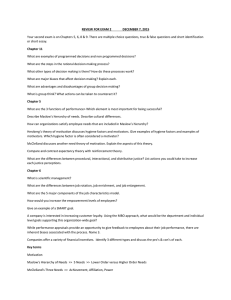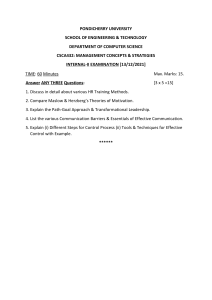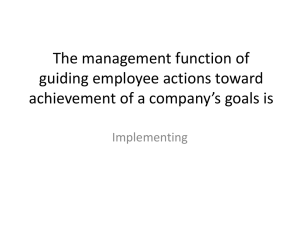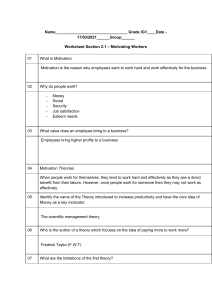Motivation Theories: Maslow, Herzberg, McGregor, McClelland
advertisement
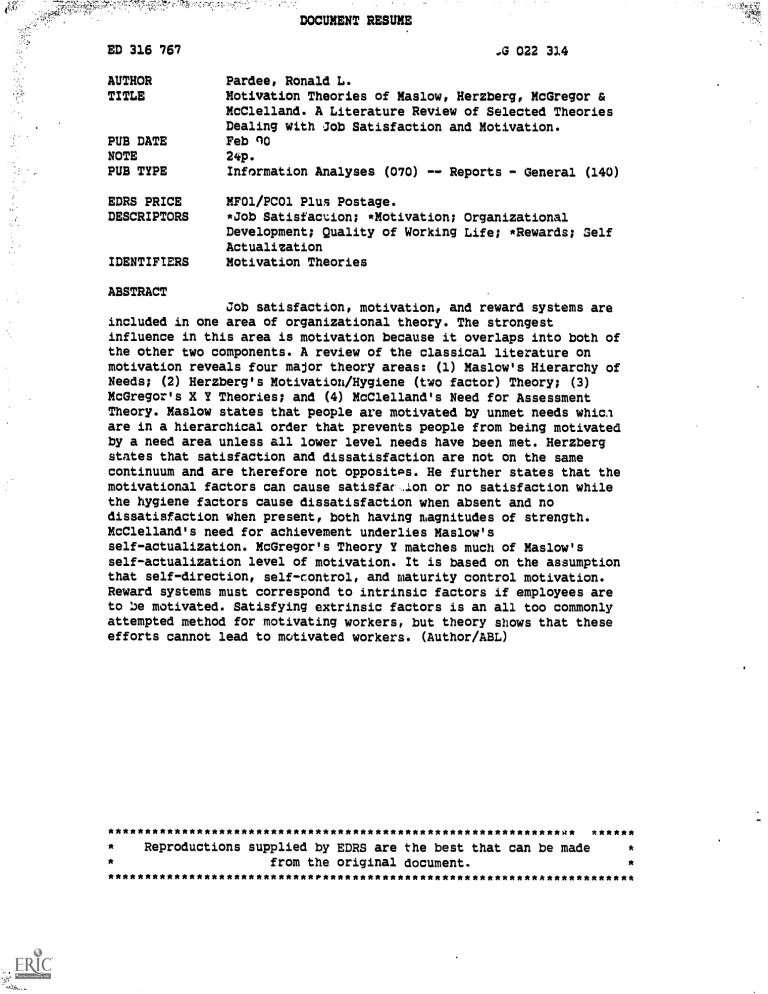
DOCUMENT RESUME ED 316 767 AUTHOR TITLE PUB DATE NOTE PUB TYPE EDRS PRICE DESCRIPTORS IDENTIFIERS .G 022 314 Pardee, Ronald L. Motivation Theories of Maslow, Herzberg, McGregor & McClelland. A Literature Review of Selected Theories Dealing with Job Satisfaction and Motivation. Feb nO 24p. Information Analyses (070) -- Reports - General (140) MF01/PC01 Plus Postage. *Job Satisfaction; *Motivation; Organizational Development; Quality of Working Life; *Rewards; Self Actualization Motivation Theories ABSTRACT Job satisfaction, motivation, and reward systems are included in one area of organizational theory. The strongest influence in this area is motivation because it overlaps into both of the other two components. A review of the classical literature on motivation reveals four major theory areas: (1) Maslow's Hierarchy of Needs; (2) Herzberg's Motivation/Hygiene (two factor) Theory; (3) McGregor's X Y Theories; and (4) McClelland's Need for Assessment Theory. Maslow states that people are motivated by unmet needs whici are in a hierarchical order that prevents people from being motivated by a need area unless all lower level needs have been met. Herzberg states that satisfaction and dissatisfaction are not on the same continuum and are therefore not opposites. He further states that the motivational factors can cause satisfar _Lon or no satisfaction while the hygiene factors cause dissatisfaction when absent and no dissatisfaction when present, both having magnitudes of strength. McClelland's need for achievement underlies Maslow's self-actualization. McGregor's Theory Y matches much of Maslow's self-actualization level of motivation. It is based on the assumption that self-direction, self-control, and maturity control motivation. Reward systems must correspond to intrinsic factors if employees are to be motivated. Satisfying extrinsic factors is an all too commonly attempted method for motivating workers, but theory shows that these efforts cannot lead to motivated workers. (Author/ABL) *************************************************************g* ****** Reproductions supplied by EDRS are the best that can be made from the original document. *********************************************************************** .11 "PERMISSION TO REPRODUCE THIS MATERIAL HAS BEEN GRANTED BY U.S. DEPARTMENT OP EDUCATION Office of Educational Research and Improvement iUCATIONAL RESOURCES INFORMATION CENTER (ERIC) This document has been reproduced as received from the person or organization originating it Minor changes have been made to improve CIO reproduction Quality TO THE EDUCATIONAL RESOURCES INFORMATION CENTER (ERIC)." Points of view or opinions stated in thisdocu. ment do not necessarily represent °thew OERI position or policy LITERATURE REVIEW Motivation Theories of Maslow, Herzberg, McGregor & McClelland A Literature Review of Selected Theories Dealing With Job Satisfaction and Motivation by Ronald L. Pardee February 1990 BEST COPY AVAILABLE SYNOPSIS OF SELECTED MOTIVATIONAL THEORIES by Ronald L. Pardee Job Satisfaction, Motivation & Reward Systems are included in one area of Organizational Theory. The strongest influence in this area is Motivation because it overlaps into both of the other two components. A review of classical literature and recent theory on (1) Maslow's motivation reveals four major theory areas: Hierarchy of Needs, (2) Herzberg's Motivation/Hygiene (two factor) Theory, (3) McGregor's X Y Theories, and (4) McClelland's Need for Achievement Theory. Maslow states that people are motivated by unmet needs which are in a hierarchical order that prevents us from being motivated by a need area unless all lower level needs have been met. Herzberg states that satisfaction and dissatisfaction are not on the same continuum and are therefore not opposites. He further states that the motivational factors can cause satisfaction or no satisfaction while the hygiene factors cause, dissatisfaction when absent and no dissatisfaction when present, both having magnitudes of strength. This theory was developed from an industrial setting and some critics question its validity outside of that area, particularly if the critical incident method is not used for data collection. McClelland's need for achievement underlies Maslow's self actualization. The similarities to Herzberg are that high achievers tend to intersted in Herzberg's motivators while low achievers are more concerned about hygiene factors.. McGregor's Theory Y matches much of Maslow's self actualizaIt is based on the assumption that tion level of motivation. self-direction, self-control, and maturity control motivation. Reward systems must correspond to intrinsic factors if employees are to be motivated. Satisfying extrinsic factors is an all to commonly attempted method for motivating workers, but theory shows that these efforts cannot lead to motivated workers. Table of Contents 1. Introduction 1 2. Definitions of Motivation 2 3. General Discussion of Motivation 4. Overview of Theories O 3 4 Maslow Herzberg McClelland 5. Motivation in the Workplace 11 6. Comparison of Theories 13 7. Summary & Conclusions .. ii 15 2 Introduction Motivation is such an important element in improving work productivity, every educational administrator needs to have a firm understanding of how it relates to job satisfaction and reward systems. Based on numerous state and national studies concerning the condition of schools, a great deal of time, energy, and effort is expended by educational administrators trying to improve the effectiveness and efficiency of educational delivery systems. Understanding job satisfaction and work motivation can be key elements to improving educational productivity. A review of the literature on motivation from three of the foremost theorists on motivation, Maslow, Herzberg and McClelland, indicates that typical reward system used in public schools satisfies only the hygiene factors and does not address the higher level needs that truly motivate people. Changing how we attempt to motivate employees requires a deeper understanding of these two motivational theories. The purpose of this literature review is to present an overview of three of the theories that explain motivation in the workplace and address the factors that contribute to job satisfaction (motivation) or cause job dissatisfaction. The classic theories of motivation from Maslow, Herzberg and McClelland presented in this paper focus on how each theory 3 supports the other and how they are applicable in the workplace. Definitions of Motivation A motive what prompts a person to act in a certain way or at least develop an inclination for specific behavior (Kast and Rosenzweig 1985, 296), "Motivation" can be defined as those forces within an individual that push or propel him to satisfy basic needs or wants (Yorks 1976, 21). The level of needs will determine what rewards will satisfy an employee. According to Dessler, most psychologists believe that all motivation is ultimately derived from a tension that results when one or more of our important needs are unsatisfied (Dessler 1986, 332). Maslow also states that "Only unsatisfied needs provide the sources of motivation; a satisfied need creates no tension and therefore no motivation". (Burke 1987, 32). 2 It is common that three qualities are included in most definitions of motivation: force, (1) it is a presumed internal (2) that energizes for action, and (3) determines the direction of action (Russell 1971, 5) . Thus far, the motivational process has been viewed as a decision-making process which takes place within the employee (Aldag 1979, 27). Vroom defines motivation as a process governing choices made by persons among alternative forms of voluntary activity (Hamner and Organ 1978, 142). Motivators are the 4 factors that arouse, direct and sustain increased performance (Duttweiler 1986, 371). General Discussion of Motivation Essentially, three factors explain why some employees are motivated to work, while others are not: 1) The motivation to work varies widely in people. 2) In the past decade, there has been a significant change in many employees' attitudes toward work. 3) The increase in various government social support programs has contributed significantly to the decline in work motivation in many people (Stanton 1983, 211) . The conceptual underpinnings of the various motivational principles put forth by psychologists were predicated on the fact that America had a powerful, impressive, and magrO.ficent industrial machine that offered the prospect of considerable prosperity for all of its citizens (Stanton 1983, 210). However, while the rest of the world seemed hell-bent on becoming more productive, much of our work force dropped the work ethic as though it were something to be ashamed of. Instead of striving for superior perform- ance, their goal was more pay and less work (Rogers and Levey 1987, 7). In addition to employees who are no longer easily motivated, the employers who subscribe to the Protestantethic have no appreciation for their subordinates' hygiene needs, and create employee dissatisfaction as a consequence (Herzberg 1976, 92) . 5 Other theorists look at workaite motivation differently. An example is McGregor's Theory Y which postulates that people can be basically self - directed and creative at work if properly motivated (Hersey and Blanchard 1982, 48). Overview of Theories Maslow's Hierarchy of Needs Abraham Maslow believed that man is inherently good and argued that individuals possess a constantly gro 'hg inner drive that has great potential. The needs hierarchy system, devised by Maslow (1954), is a commonly used scheme for classifying human motives. It involves five categories of motives arranged with lower-level needs on the bottom which must be satisfied first, before the higher level needs come into play (Wallace, Goldstein and Nathan 1987, 277). The five general levels of needs as described by Hamner and Organ are shown in the following hierarchical order. 1.) Physiological needs: Food, water, sex, and shelter 2.) Safety needs: Protection against danger, threat, and deprivaBehavior which arou.e!-; uncertainty with tion. respect to continued employment or which reflects favoritism or discriminatio-. unpredictable administration of policy are powerful motivators of the safety needs in the employment relationship at every level (Hamner and Organ 1978, 137). 3.) Social needs: Giving and receiving of love, friendship, affection, belonging, association, and acceptance. (If the first two levels are fairly well gratifiQd a person becomes keenly aware of the absence of friends.) 6 4.) Ego needs: * Need for achievement (n Ach), adequacy, strength, and freedom. Tn essence this is the need for autonomy or independence. * Status, recognition, appreciation, and prestige. In essence this is the need for self-esteem or self-worth. 5.) Self-actualization needs: The need to realize one's potentialities for continued self development and the desire to become more and more of what one is and what one is capable of becoming. (The conditions of modern industrial life afford only limited opportunity for the self-actualizing need to find expression.) (Hamner and Organ 1978, 138). Two major postulates can be derived from Maslow's need hierarchy. They are: (1) A satisfied need is not a motivator of behavior. (2) To the extent that lower-order needs become satisfied, the next higher-order level of needs becomes the most prepotent determinant of behavior (Hamner and Organ 1978, 139). The extent that jobs incorporate elements that satJ.sfy some higher order human needs determines their potential for motivating workers (Imel 1982, 3) . A person's level of aspiration is closely related to the hierarchy of needs (Haimann 1973, 217), and attitudes will determine the individual route which the person takes for the satisfaction of his needs (Haimann 1973, 219). The ultimate need category described by Maslow was that of self-actualization. This belief served as the basis for the assumptions of McGregor's Theory Y viewpoint on motivation which was based on self-direction, self-control, motivation and maturity (McGregor 1960, 47-48). 5 7 Herzberg's Motivation Hygiene Theory Herzberg's motivation hygiene theory is often called the two factor theory and focuses on those sources of motivation which are pertinent to the accomplishment of work (Hall and Williams 1986, 6). Herzberg concluded that job satisfaction and dissatisfaction were the products of two separate factors: motivating factors (satisfiers) and hygiene factors (dissatisfiers) respectively: Dissatisfiers Satisfiers 1. 2. 3. 4. 5. 6. Achievement Recognition Work itself Responsibility Advancement Growth 1. 2. 3. 4. 5. 6. 7. 8. Company Policy Supervision Working conditions Interpersonal relations Salary Status Job security Personal life (Herzberg, Mousner, and Snyderman, 1959, 59-83). Herzberg used the term "hygiene" in the medical sense - the sense that it operates to remove hazards from the environment (Duttweiler 1986, 371). Herzberg identifies and compares the dynamics of hygiene and motivation as illustrated below. The Dynamics of Hygiene *The psychological basis of hygiene needs is the avoidance of pain from the environment - APE *There are infinite sources of pain in the environment *Hygiene improvements have short-term effects *Hygiene needs are cyclical in nature *Hygiene needs have an escalating zero point *There is no final answer to hygiene needs 8 The Dynamics of Motivation *The psychological basis of motivation is the need for personal growth *There are limited sources of motivator satisfaction *Motivator improvements have long-term effects *Motivators are additive in nature *Motivator needs have a nonescalating zero point *There are answers to motivator needs (Herzberg 1976, 101) According to Herzberg, hygiene cannot motivate, and when used to achieve this goal it can actually produce negative effects over the long run. A "hygienic" environ- ment prevents discontent with a job, but such an environment cannot lead the individual beyond a minimal adjustment consisting of the absence of dissatisfaction. A positive "happiness" seems to require some attainment of psychological growth (Herzberg 1966, 78, 89). The hygienes have always been - and probably always will be - easier to measure, control, and manipulate than the motivators. The motivators are more complex and sub- jective, and often too elusive to measure. But to the extent that management concentrates on hygienes, while at the same time neglecting motivators, workers are probably going to seek more of the hygienes (Hamner and Organ 1978, 155). This has a negative effect on developing a motivated workforce. 9 The proper management of hygiene is an important first step in applying Herzberg's two factor theory, which is shown in a five part process a shown below. The proper management of hygiene I 1. Identify type of hygiene 2. Give hygiene for hygiene purposes 3. Give hygiene for what hurts 4. Keep hygiene administration simple' 5. Give it and shut up about it Fig. 1. The five rules for administering hygiene 1976, 93) (Herzberg . The fact that joh satisfaction is made up of two unipolar traits is not unique, but it remains a difficult concept to grasp. The opposite of job satisfaction would not be job dissatisfaction, but rather no job satisfaction; similarly, the opposite of job dissatisfaction is no job dissatisfaction, not satisfaction with one's job (Herzberg 1976, 76) . Herzberg also says, "A deprivation in hygiene factors can lead to job dissati 1.,:tion, but their amelioration does not lead to job satisfaction." (Herzberg 1976, 61). Hersey describes hygiene saying, "Hygiene factors, when satisfied, tend to eliminate dissatisfaction and work restriction, but they do little to motivate an individual to superior performance or increased capacity." 1982, 59) . (Hersey and Blanchard 10 There are three primary psychological states that significantly affect worker satisfaction: 1. Experienced meaningfulness of the work itself 2. Experienced responsibility for the work and its outcomes 3. Knowledge of results, or performance feedback The more that work is designed to enhance these states, the more satisfying the work will be (Wallace 1987, 275 and Burke 1987, 35). The dimension of job dissatisfaction differs psychologically from job satisfaction, but it is also associated with an escalation phenomenon, or what some have called she principle of (rising expectations): the more people receive, the more they want (Burke 1987, 33) . This clarifies Herzberg's escalating zero point statement. Mathis said it this way, "Hygiene factors provide a base which must be carefully considered if dissatisfaction is to be avoided. But, even if all of the maintenance needs are taken care of, the people will still not necessarily be motivated to work harder." (Mathis 1979, 55). Herzberg suggests that factors that lead to job satisfaction are primarily intrinsic, whereas factors leading to job dissatisfaction are primarily extrinsic. The cluster of intrinsic factors was found to include the work itself, achievement, advancement, recognition, and responsibility. The cluster of extrinsic factors was found to include supervision, interpersonal relations, working conditions, 4 3 11 salary, company policies, and administration (Caston and Braoto 1985, 270) . At times, Herzberg seems to indicate that intrinsic factors will not lead to job satisfaction if the extrinsic factors present in the work setting are deficient (Caston and Braoto 1985, 281). An employee experiencing a state of intrinsic motivation tends to be committed to the job and self-fulfillment through it (Aldag 1979, 11). In a state of intrinsic motivation, the employee attributes job behaviors to outcomes which are derived from the work itself. Such intrinsic outcomes are experienced by employees independent of the involvement of others (Aldag 1979, 11 & 22) . McClelland's Need for Achievement Theory McClelland has proposed a theory of motivation that is closely associated with learning concepts. The theory proposes that when a need is strong in a person, its effect is to motivate the person to use behavior which leads to satisfaction of the need. The main theme of McClelland's theory is that needs are learned through copping with one's environment. Since needs are learned, behavior which is rewarded tends to recur at a higher frequency (Gibson, Ivancevich and Donnelly, 1979, 111-112). The need for achievement or n Ach involves the desire to independently master objects, ideas and other people, and to increase one's self-esteem through the exercise of one's 14 12 talent. (Wallace, Goldstein and Nathan 1987, 289) Based on research results, McClelland developed a descriptive set of factors which reflect a high need for achievement. These are: 1. Achievers like situations in which they take personal responsibility for finding solutions to problems. 2. Achievers haw, a tendency to set moderate achievement goals and take "calculated risks." 3. Achievers want concrete feedback about how well they are doing (McClelland and Johnson, 1984, 3). Motivation in the Workplace If the treatment of employees is reasonably good but they express few positive attitudes toward their work and are unwilling to extend any extra effort for the company, then the organization has a motivation problem (Herzberg 1976, 94) . The effective manager must know what motivates someone to perform and how to satisfy the needs of the employee (Ferguson 1987, 149). Hamner stated this in another way by saying that in order to understand how to motivate their subordinates, managers need to know what energizes human behavior (Hamner and Organ 1978, 137). We must realize that different people want various things from their job and there are different leadership styles; not one way or method of motivation will satisfy everyone (Stanton 1983, 208). Since motivation gives direction and intensity to human behavior (Frymier 1974, t5 13 16), it follows that people will be highly motivated when they believe 1) that their behavior will lead to certain rewards, 2) that these rewards are worthwhile and valuable, and 3) that they are able to perform at a level that will result in the attainment of the rewards (Burke 1987, 34). Our problem in the immediate future will be not the lack of opportunities for the really motivated, but the lack of motivated people ready and able to take advantage of the opportunities (Rogers and Levey 1987, 10). Hersey relates that esteem and self-actualization seem to become more important as people mature (Hersey and Blanchard 1982, 56). Hamner agrees by stating that the energizing force of behavior shifts over a person's work life (Hamner and Organ 1978, 141). Therefore, in order to motivate older workers higher level needs must be satisfied. Herzberg's theory can be very helpful to a manager in deciding how to develop a motivated workforce. If worker dissatisfaction is seen as the major problem, then the hygiene factors must be improved. But to improve perform- ance the manager must work on the motivators, and this means changing the nature of the work to make it more challenging and intrinsically rewarding (Tosi, Rizzo, and Carroll 1986, 223) . The components of an organizational reward system, such as money, fringe benefits, and promotion, must be desired by the employee; that is, they must be positively valent in the employee's ordering of preferences. 6 The 14 employee must perceive that variations in performanc( level will lead to variations in the amount of reward received (Hamner and Organ 1978, 146). Herzberg explains money as a motivator saying, "Because of its ubiquitous nature, salary commonly shows up as a motivator as well as a hygiene. Although primarily a hygiene factor, it also often takes on some of the properties of a motivator, with dynamics similar to those of recognition for achievement." (Herzberg 1976, 71). Examples of extrinsic outcomes could include pay increases, promotions, or fringe benefits. The extrin- sically motivated employee tends to feel a lack of control over on-the-job behavior (Aldag 1979, 21). Because human beings seek to satisfy two basic need systems, the management of people involves two problems - the proper management of hygiene needs and the proper management of the motivators (Herzberg 1976, 84). Comparison of Theories Herzberg argues that only the goal objectives associated with Maslow's ego-status and self actualization needs provide motivation or satisfaction on the job. Meeting the lower order needs simply reduces dissatisfaction; it does not provide satisfaction (Burke 1987, 33). The relationship between Maslow's hierarchy of needs and Herzberg's motivation-hygiene theory have been compared by some researchers and have been depicted by overlaying 15 Herzberg's two-track continuum over Maslow's pyramid of The stair step representation shown by Hersey shows needs. the relationship that exists between the Maslow and Herzberg frameworks. MOTIVATORS ISelf-Actualization Esteem Social (Affiliation) I Safety (Security) 1 Physiological 1 HYGIENE FACTORS I The Relationship Between the Motivation-Hygiene Fig. 2. (Hersey and Theory and Maslow's Hierarchy of Needs Blanchard 1982, 60). McClelland's concept of achievement motivation is also related to Herzberg's motivation-hygiene theory. People with high achievement motivation tend to be interested in the motivators. People with low achievement motivation are more concerned about the environment (Hersey and Blanchard 1982, 61) . "Although not stated specifically in Maslow's need hierarchy, the need for achievement underlies self actualization." (Kast and Rosenzweig, 1970, 295). proposed no lower order needs. McClelland While his need for achievement is not identical with Herzberg's motivators, or Maslow's higher order needs, there are some similarities. 16 The major differences is McClelland's emphasis on socially acquired needs (Gibson, Ivancevich and Donnelly 1979, 112). Maslow is helpful in identifying needs or motives and Herzberg provides us with insights into the goals and incentives that tend to satisfy the needs (Hersey and Blanchard 1982, 59). One major means of increasing an employee's level of intrinsic motivation is through changing the work itself (Aldag 1979, 22). tion. This can be done through job rehabilita- Rehabilitating jobs is called job enrichment (Herzberg 1976, 95). However, Aldag has said, "Employees dissatisfied with extrinsic factors are unlikely to respond well to job enrichment attempts." (Aldag 1979, 101). Job enrichment, a significant intervention within OD (Organizational Development) and a critical element of quality-of-work-life (QWL) projects, is a direct application of Herzberg's theory and at least an indirect application of Maslow's theory (Burke 1987, 34). Summary and Conclusions This literature review showed that there is a clear relationship between Maslow's Hierarchy of Needs Theory, Herzberg's Two Factor Theory of Motivation and McClelland's need for achievement theory. This relationship shows the overlap of higher level needs and motivators and the corresponding overlap of hygiene and lower order needs. The lower order needs must be met before higher order needs can 17 have any motivational force and Herzberg's parallel hygiene factors rust be met to prevent job dissatisfaction. Maslow's higher order needs serve to motivate people and are of an intrinsic nature ..111 corresponds to Herzberg's motivational factors that ire also intrinsic in nature. Hersey said it clearly when he stated, "Management by direction and control may not succeed because it is a questionable method for motivating people whose physiological and safety needs are reasonably satisfied and whose social, esteem, and self-actualization needs are becoming predominant." (Hersey 1982, 48). Further analysis of these theories leads to the conclusion that when managers incorporate motivations:. elements in work settings rather than simply eliminating adverse hygiene factors, they can expect to see higher productivity and job satisfaction. This seems to be a paradox in many working environments where a great deal of time, energy and effort is expended on extrinsic factors which do not lead to job satisfaction/motivation, but only serve to reduce job dissatisfaction. The thrust of all of the motivational theories reviewed is that managers should carefully review what they are incorporating into reward systems. If the rewards are predominantly extrinsic factors then all that can be hoped for are employees who are not dissatisfied with their work. Satisfying hygiene needs is relatively simple, but the satisfaction is short-lived and these types of needs are not additive in nature. Motivation can be achieved only by satisfying a very limited area of complex needs, which are additive in nature and whose satisfaction results in much more long lasting effect. What is actually required, therefore, is a two-way effort which is directed first at the hygiene and then at the development of motivation (Haimann 1973, 224). Bibliography Aldagi Ramon J. Task Design and Employee Motivation. Glenview, IL: Scott, Foresman and Company, 1979. Burke, W. Warner. Organizational Development. Addison-Wesley Publishing Company, 1987. Reading, MA: Carpenter, Karen D. "The Relationship Between Job Characteristics, Work Motivation, and General Job Satisfaction of Academik., Middle Managers for Baccalaureate Nursing." Ph.D. diss., University of South Carolina, 1988. Caston, Richard J. and Rita Braoto. "The Worker-toJob "Fit" Hypothesis Some Further Evidence." Work and Occupations 12 (Aug 1985): 269-284. "A Laboratory examination of Goal Theory Danehower, Carol. Propositions in the Context of the social learning Mechanisms of Motivation." D.B.A. diss., University of Kentucky, 1987. Dessler, Gary. Organization Theory, Integrating Structure Second Edition, Englewood Cliffs, New and Behavior. Jersey: Prentice-Hall, Inc., 1986. Educational Excellence and Duttweiler, Patricia C. Motivating Teachers. Eric Journal The Clearinghouse. April 1986. ERIC, EJ 275 791. Frymier, Jack R. Motivation and Learning in School. Bloomington, IN: Phi Delta Kappa Educational 1974. Foundation. Ferguson, Diane B. Management Styles and Employee II, Motivation. Edited by R. Wilkins. Vol. Administrative Manual. Arlington, VA: American Association of Blood Banks. 1987. Gardner, John W. Self-Renewal The Individual and The Innovative Society. New York: W.W. Norton & 1981. Company. Gibson, James L., John M. Ivancevich, James H. Donnelly, Organizations; Behavior, Structure, Process, Dallas, Texas: Business Publications, Inc., 1979. Haimann, Theo. Supervisory Management For Health Care Institutions. St. Louis: The Catholic Hospital Association. 1973. 20 Hall, Jay and Martha S. Williams. Work Motivation Inventory, The Woodlands, Texas: Telemetrics International, Inc., 1986. Hamner, W. Clay and D. Organ. Organizational Behavior An A22242cipscholoiroach. Dallas: Business Publ cations. 1978. Hersey, Paul and Ken Blanchard. Management of Organizational Behavior Utilizing Human Resources. Englewood Cliffs, NJ: Prent ce-Hall. 1982. Herzberg, Fredrick. Work and The Nature of Man. Thomas Y. Crowell Co. 1966. . New York: The Managerial Choice, To br. Lifficient and to be Human. Homewood, IL: Dow J3nes-Irwin. 1976. Herzberg, Frederick; Bernard Mausner; and Barbara Snyderman. The Motivation to Work. New York: Wiley, 1959. Imel, Susan. Quality Circles: Implications for Training. Columbus: 1982. ERIC. ED 237 810. Kast, Fremont E. and James E. Rosenzweig. Organization and Management: A Systems and Contingency Approach. New York: McGraw-Hill Book Company, 1970. Lee, David E. Pelican. The Motivating Administrator. Gretna, LA: 1981. Maslow, Abraham H. Motivation and Personality. Harper and Bros., 1954. New York: Mathis, Robert L. and John H. Jackson. Personnel Contemporary Perspectives and Applications. 2d ed. St. Paul: West Publishing Company. 1979. McClelland, David C. and Eric W Johnson. Learning to Achieve. Glenview, Illinois: Scotti. Foresman & Co., 1984. McGregor, Douglas. The Piman Side of Enterprise. New York: McGraw-Hill, 1960. Rogers, Francis G. and Irving N. Levey. 1987. Getting the Best out of Yourself and Others. New York: Harper & Row. Russell, Ivan L. Motivation. Company. 1971. Dubuque, IA: Wm. C. Brown 21 Stanton, Erwin S. "A Critical Reevaluation of Motivation, Management, and Productivity." Journal (March 1983): 208-214. Personnel Tosi, Iepry L., John Rizzo, Stephen J. Carroll. Managing Organizational Behavior. Cambridge, MA: Ballinger Publishing Company. 1986. Wallace, Patricia, Jeffrey H. Goldstein, Peter Nathan. Introduction to Psychology. Dubuque, IA: Wm. C. Brown. 1987. Yorks, Lyle. A Radical Approach to Job Enrichment. York: Amacom. 1976. New


